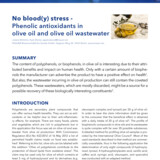
The content of polyphenols, or biophenols, in olive oil is interesting due to their attributed benefits and impact on human health. Only with a certain amount of biophenols the manufacturer can advertise the product to have a positive effect on health. But also, the wastewater incurring in olive oil production can still contain the coveted polyphenols. These wastewaters, which are mostly discarded, might be a source for a possible recovery of these biologically interesting constituents.

Chromatogram of mixed standard at calibration level 5. 1 - 3-hydroxytyrosol, 2 - Tyrosol, 3 - 4-hydroxyphenylacetic acid, 4 - Vanillic acid, 5 - Caffeic acid, 6 - Syringic acid, 7 - Oleuropein, 8 - Quercetin

Chromatogram of olive oil sample 2. 1 - 3-hydroxytyrosol, 2 - Tyrosol, 3 - vanillic acid

Amounts of phenols in samples in mg/20g

Chromatogram of olive oil sample 3. 1 - 3-hydroxytyrosol, 2 - Tyrosol, 3 - Syringic acid

Chromatogram of olive oil wastewater sample 1. 1 - 3-hydroxytyrosol, 2 - Tyrosol, 3 - Vanillic acid

Chromatogram of olive oil wastewater sample 2. 1 - 3-hydroxytyrosol, 2 - Tyrosol, 3 - Oleuropein

SPE method parameters
| Method | HPLC |
|---|---|
| Mode | RP |
| Substances | 3-Hydroxytyrosol, Tyrosol, 4-Hydroxyphenylacetic acid, Vanillic acid, Caffeic acid, Syringic acid, Oleuropein, Quercetin |
| Key words | Antioxidants, polyphenols, biophenols, olive oil, International Olive Council, 3-Hydroxytyrosol, Tyrosol, 4-Hydroxyphenylacetic acid, Vanillic acid, Caffeic acid, Syringic acid, Oleuropein, |
| CAS number | 10597-60-1, 331-39-5, 32619-42-4, 156-38-7, 501-94-0, 117-39-5, 530-57-4, 121-34-6 |
| Version | 1/12-2020 |

We are happy to help you